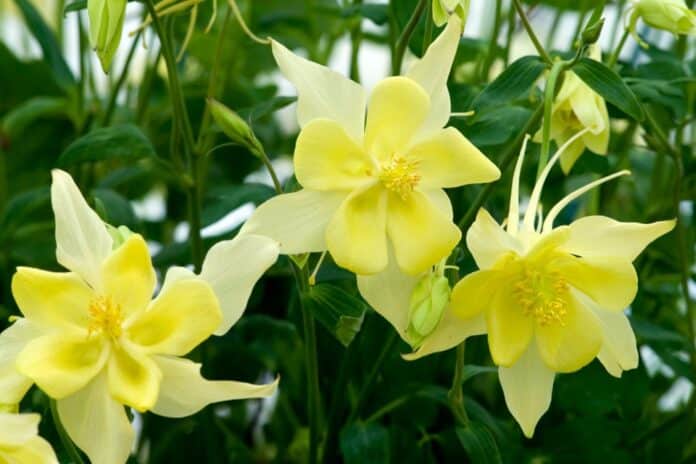The following derives from my own experiences as a gardener. It is not meant to be the only way to do things; it is just what works for me. If you have better ways, please tell us about them in the comments.
Killing Weeds
Salt + Detergent + Water
This works on small areas like pathways and areas in which we don’t want any plant growth.
Mixing salt, detergent, and water creates a homemade herbicide that can kill weeds due to the following mechanisms:
- Salt (Sodium Chloride): Salt is highly effective at killing plants by drawing water out of their cells through osmosis. This process dehydrates the plant tissues, leading to the death of the weed. Salt also disrupts the plant’s nutrient uptake, making it difficult for the plant to survive.
- Detergent (Surfactant): Detergent acts as a surfactant, which reduces the surface tension of the water. This allows the solution to spread more easily and stick to the leaves of the weeds, improving the absorption of the salt into the plant. Additionally, the detergent can break down the protective waxy coating on leaves, further allowing the salt to penetrate the plant tissues.
- Water: Water is the carrier for the salt and detergent, enabling even application of the solution across the weeds. Once applied, the water helps to dissolve the salt, allowing it to be absorbed more efficiently by the plant.
How It Works:
- When the mixture is applied to weeds, the salt draws moisture out of the plant cells, leading to desiccation (drying out). The detergent enhances the effectiveness by ensuring the mixture adheres to the leaves, maximising contact and absorption.
- Over time, this leads to the plant’s inability to carry out photosynthesis and absorb essential nutrients, ultimately killing it.
This method is particularly effective on small, young weeds but can also affect the soil, preventing future plant growth, so it should be used cautiously.
For larger areas and areas in which other plant growth is desired, then it is good old-fashioned effort and time. Personally, I use a heat gun which kills the root. However, one still needs to pull out the weed and the dead root. From then on, be watchful of new weeds returning and kill them off while they are young.
Slugs
There are approximately 250,000 slugs per acre. They serve a vital function by recycling vegetative waste back into the garden….
Do not use pellets, as it can harm other wildlife and pets.
The key is to attract their predators into the garden. Thus, plenty of foliage and also a pond would be of great use. Slugs are the diet of plenty of animals, and the cycle of nature is much more effective and safe than applying chemical warfare upon them. This may lead to some collateral damage, but in the long term it is worth it for the garden as a whole.
If concerned about plants in the garden, then the best bet is to keep the young ones raised on a table until they are strong and resilient.
Growing plants
Do not mollycoddle plants. They were here long before humans, and they will be here a long time after humans have exited. Their strength derives from adapting to an environment with as little intervention as possible. Watering during prolonged dry periods is helpful, as is protecting from predators (see slugs above). However, after having complied with planting instructions, our best way forward is to leave the plant to it and let it do its thing.
Whether you’re an experienced green thumb or just starting out, a few well-timed tips can make all the difference in the garden. Here’s a collection of 20 other practical, tried-and-tested gardening tips to help you grow healthier plants, maximise your space, and enjoy your garden all year round.
- Know Your Soil Type
Understanding whether your soil is sandy, clay, loamy, or chalky is essential. Conduct a simple soil test to determine its pH and texture so you can choose plants that will thrive in your garden. - Feed Your Soil, Not Just Your Plants
Healthy soil equals healthy plants. Regularly add organic matter like compost or well-rotted manure to improve structure and fertility. - Water Deeply, Not Frequently
Rather than giving your plants a light sprinkle daily, water them deeply but less often. This encourages deeper root growth and improves drought tolerance. - Collect Rainwater
Install a water butt to collect rainwater from your gutters. It’s better for your plants and helps conserve mains water. - Mulch to Retain Moisture
Apply a layer of mulch around plants to help retain soil moisture, suppress weeds, and improve soil health over time. - Companion Planting Works Wonders
Planting certain plants together can naturally deter pests and improve yields. For example, marigolds repel aphids and attract beneficial insects. - Deadhead Flowers Regularly
Snip off spent blooms to encourage more flowers to grow, keeping your garden colourful throughout the season. - Start a Compost Heap
Recycle kitchen scraps and garden waste into nutrient-rich compost. It’s an eco-friendly way to nourish your plants. - Prune at the Right Time
Learn the correct time to prune each plant. For example, prune roses in late winter, and spring-flowering shrubs right after they bloom. - Use Coffee Grounds as Fertiliser
Sprinkle used coffee grounds around acid-loving plants like azaleas and blueberries. It boosts nitrogen levels and deters slugs. - Create Wildlife Habitats
Encourage natural predators like ladybirds and hedgehogs by providing habitats. They’ll help keep pests under control. - Rotate Your Vegetable Crops
Practise crop rotation to prevent soil-borne diseases and pest build-up and to maintain soil fertility. - Label Your Plants
Use durable, weatherproof labels to keep track of what you’ve planted — especially useful in the early stages of growth. - Sow Little and Often
Instead of planting everything at once, sow seeds in small batches every couple of weeks to enjoy a continuous harvest. - Sharpen Your Tools
Keep secateurs, spades, and hoes sharp. Sharp tools make cleaner cuts, reducing plant stress and disease risk. - Protect Young Plants from Frost
Use cloches, fleece, or even upturned pots to shield tender young plants from unexpected late frosts. - Encourage Pollinators
Plant a variety of nectar-rich flowers to attract bees and butterflies, essential for fruit and vegetable pollination. - Recycle Household Items
Use yoghurt pots for seed starting or old kitchen utensils as plant supports. It saves money and reduces waste. - Don’t Overcrowd Plants
Give your plants adequate space to grow. Overcrowding can lead to poor air circulation, increasing the risk of disease. - Enjoy the Process
Take time to observe and appreciate your garden. Gardening is as much about enjoying nature as it is about results.
Not only is gardening enjoyable, but it is great exercise and wonderful for our mental health. Being with nature just outside our homes is pure joy.
Go get stuck in.







